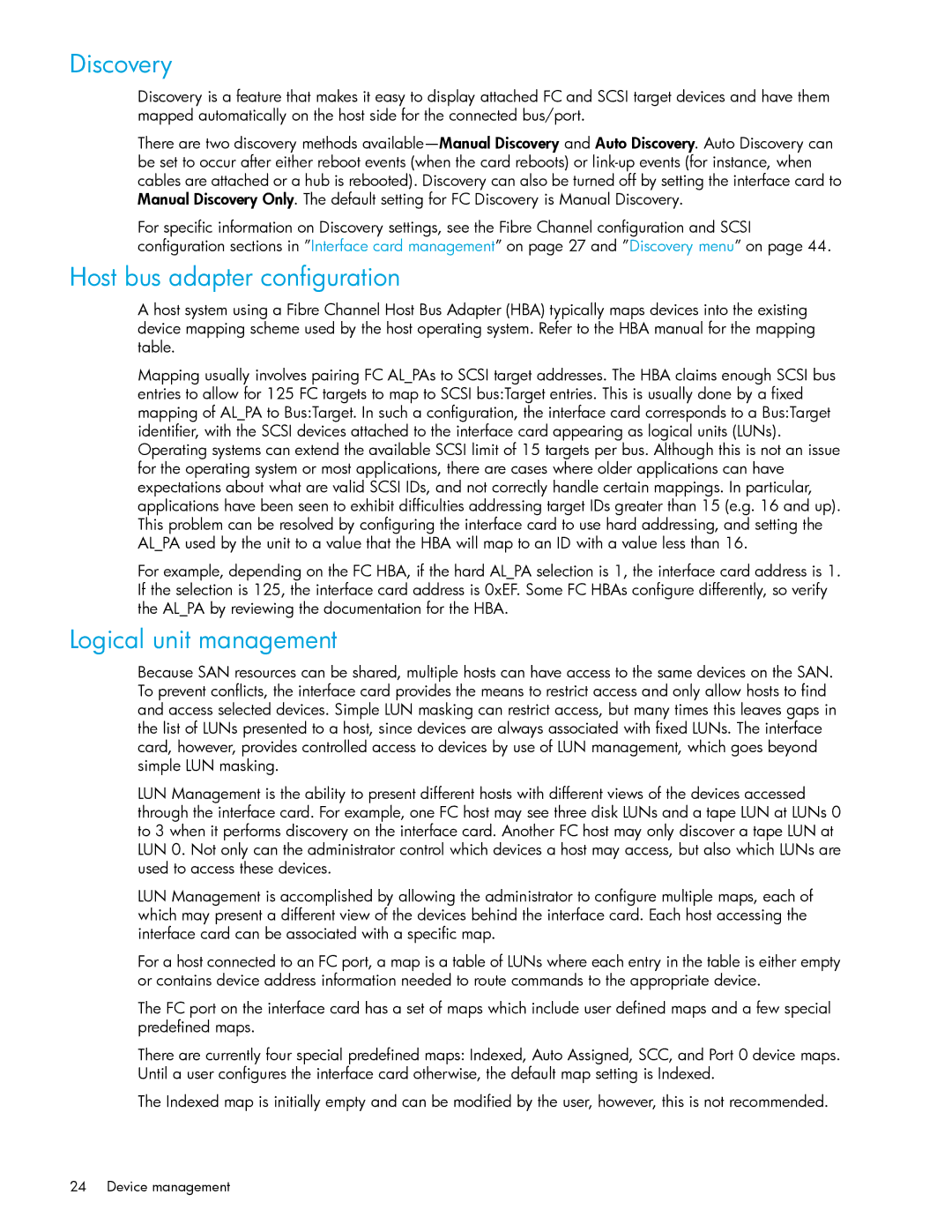Discovery
Discovery is a feature that makes it easy to display attached FC and SCSI target devices and have them mapped automatically on the host side for the connected bus/port.
There are two discovery methods
For specific information on Discovery settings, see the Fibre Channel configuration and SCSI configuration sections in ”Interface card management” on page 27 and ”Discovery menu” on page 44.
Host bus adapter configuration
A host system using a Fibre Channel Host Bus Adapter (HBA) typically maps devices into the existing device mapping scheme used by the host operating system. Refer to the HBA manual for the mapping table.
Mapping usually involves pairing FC AL_PAs to SCSI target addresses. The HBA claims enough SCSI bus entries to allow for 125 FC targets to map to SCSI bus:Target entries. This is usually done by a fixed mapping of AL_PA to Bus:Target. In such a configuration, the interface card corresponds to a Bus:Target identifier, with the SCSI devices attached to the interface card appearing as logical units (LUNs). Operating systems can extend the available SCSI limit of 15 targets per bus. Although this is not an issue for the operating system or most applications, there are cases where older applications can have expectations about what are valid SCSI IDs, and not correctly handle certain mappings. In particular, applications have been seen to exhibit difficulties addressing target IDs greater than 15 (e.g. 16 and up). This problem can be resolved by configuring the interface card to use hard addressing, and setting the AL_PA used by the unit to a value that the HBA will map to an ID with a value less than 16.
For example, depending on the FC HBA, if the hard AL_PA selection is 1, the interface card address is 1. If the selection is 125, the interface card address is 0xEF. Some FC HBAs configure differently, so verify the AL_PA by reviewing the documentation for the HBA.
Logical unit management
Because SAN resources can be shared, multiple hosts can have access to the same devices on the SAN. To prevent conflicts, the interface card provides the means to restrict access and only allow hosts to find and access selected devices. Simple LUN masking can restrict access, but many times this leaves gaps in the list of LUNs presented to a host, since devices are always associated with fixed LUNs. The interface card, however, provides controlled access to devices by use of LUN management, which goes beyond simple LUN masking.
LUN Management is the ability to present different hosts with different views of the devices accessed through the interface card. For example, one FC host may see three disk LUNs and a tape LUN at LUNs 0 to 3 when it performs discovery on the interface card. Another FC host may only discover a tape LUN at LUN 0. Not only can the administrator control which devices a host may access, but also which LUNs are used to access these devices.
LUN Management is accomplished by allowing the administrator to configure multiple maps, each of which may present a different view of the devices behind the interface card. Each host accessing the interface card can be associated with a specific map.
For a host connected to an FC port, a map is a table of LUNs where each entry in the table is either empty or contains device address information needed to route commands to the appropriate device.
The FC port on the interface card has a set of maps which include user defined maps and a few special predefined maps.
There are currently four special predefined maps: Indexed, Auto Assigned, SCC, and Port 0 device maps. Until a user configures the interface card otherwise, the default map setting is Indexed.
The Indexed map is initially empty and can be modified by the user, however, this is not recommended.
24 Device management
